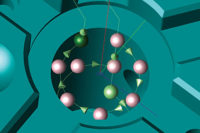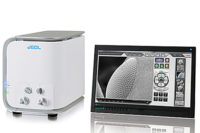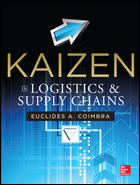Analog sensors have been available for decades. While this approach is well understood, and the necessary analog input cards are available for all PLC brands, analog data comes with its own sets of issues. The need to protect sensitive signals by employing shielded cable is just one of them.
With the introduction of industrial networks, sensors offering positional data were soon offered with direct connections to these networks. This is a sensible approach for costly, high-performance products, especially when the cost of the network connection is low compared to the sensing hardware itself. High-precision, long-range distance measurement devices (as seen in Figure 1) used in AS/RS positioning fall into this product category. Sensors with repeat accuracy of 1 mm or less allow high-bay storage with unparalleled density. While in the past it was necessary to construct oversized storage locations to make up for inaccuracies of the AS/RS movement, this is no longer necessary. Being able to reduce the size of a 1 meter storage location by just 2 cm allows 102 bays where previously only 100 bays could be implemented. Because this is now possible without increasing the floor space or building size, it represents a 2% net cost reduction of the facility.
Since the number of available analog sensors on the market is significant, providers of industrial networking technologies quickly came up with solutions that allowed any arbitrary analog transducer to be connected to the network. Figure 2 shows a low-cost analog input module that couples two transducers to the open AS-Interface network. Besides the known advantages of a low-cost infrastructure, short installation and commissioning time, connectivity to every major PLC on the market, and fast and deterministic update speeds, this approach adds the benefit of reducing the necessary analog cable length, resulting in increased data reliability.
More recently, IO-Link has gained traction giving machine designers another method of reliably transmitting analog data to the PLC. IO-Link sensors internally convert the position data into an IO-Link data stream. Figure 3 shows a high-precision, time-of-flight photoelectric sensor providing direct numerical data feedback via IO-Link. The digitized data stream is sent to an IO-Link-enabled input block where it is transported to the PLC using an upper-level industrial network. The advantage of this approach is that the analog information is never transmitted as a low-current or low-voltage signal, but rather as a modulated 24 V data stream, resulting in increased noise immunity, making IO-Link-enabled sensors ideal for tough industrial environments. IO-Link is further enhanced by SmartBridge, a setup, monitoring, and data-logging technology that makes use of smart phones and tablet devices giving users the ability to easily configure IO-Link products in situations where the PLC doesn’t fully implement IO-Link.
While the implementation of 1D position feedback solutions can be quite elaborate depending on the required performance and accuracy, the amount of data provided by a 1-D sensor is quite limited. Imagine a distance measurement device like that shown in Figure 1. The accuracy of less than 0.5 mm over the entire measurement range of 300 m is possible only by combining a number of clever engineering principles. Still, the data output is limited as the device provides only one number coded into a few bytes of information. As soon as the need to perform distance measurement over an entire 2D plane is necessary, the amount of data generated by a sensor increases significantly.
Figure 4 shows such a 2-D measuring sensor offering over a quarter of a million scan values per second. Depending on the application, AGV navigation for instance, these kinds of 2-D scanners must offer fine angular resolution as well as precise distance determination combined with a long detection range and high update rate. Consequently, the amount of raw data generated by such high-end devices is significant and well outside of the capabilities of most normal PLCs and industrial networks, including EtherNet/IP and PROFINET. In addition to high precision and faster update speed, the device shown in Figure 4 offers a set of unique advantages. The result is not only higher performance and increased reliability in terms of its mission time (20 years) and better MTTF (75 years) but also in addressing new, tough applications:
Pulse Ranging Technology (PRT) is a true, time-of-flight distance measurement process based on the emission of a nanosecond high-energy light pulse. The average energy per pulse is low, resulting in an eye-safe, Class 1 laser, while the high-energy density provides exceptional ambient light immunity (<80,000 lux). Older technologies based on phase correlation utilizing CW emitters are typically a factor of 2 to 4 lower.
Rotation measurement head. Previous generation 2-D scanners are usually based on a stationary light source deflected by a rotating mirror. This design results in a mechanically limited scanning plane where only a fraction of the 2-D plane can be evaluated. By spinning the entire emitter/receiver module a full 360°, the plane can be scanned and evaluated.
Another advantage of spinning the measurement head manifests itself in a very stable scan plane. Specifically, the angular divergence of the circular scan plane (i.e., the wobble of the plane when looked at from the side) is less than 0.05°. Rotating mirror designs not only demand proper alignment of the mirror but also require great care concerning the relative alignment of both the emitter and receiver. These additive errors result in scan-plane wobble that is typically on the order of 1° to 2°, a far cry from what is technically possible today. From an application point of view, a flat scan plane allows the 2-D scanner to be mounted much closer to the surface to be evaluated.
A third advantage that is a direct result of spinning the entire measurement head is the angular-independent shape of the measurement light spot. This is particularly important in situations where a rectangular spot (narrow in the direction of rotation and elongated in the perpendicular direction) is preferred. Such geometries allow the 2D measurement system to perform at extended ranges without reducing the all-important angular resolution. Attempting this with a rotating mirror device is not possible because the shape of the beam, which is distorted after deflection by the mirror, changes from angle to angle (Figure 5) essentially defocusing the beam and reducing the accuracy as a function measurement angle.
2-D Detection Scanners Simplifying Usage
As mentioned before, a high-precision, high-speed, full 360° 2D scanner generates so much data that a PLC, the workhorse of industrial automation control, cannot process and evaluate the information. To make these 2D measurement systems useful for PLC applications, essentially all data analysis must be performed by the scanner and then reduced to a limited number of binary data bits. One way to think about this is to envision a detection scanner that is a measurement device with an internal user application. This simplification allows a detection scanner to perform new tasks and solve new applications.
Area monitoring – Since a 2D scanner with the ability to measure the true distance to an object has the ability to see where an object is located, the detection scanner can compute the size and location of an object with regards to a user-defined field. With this information, digital outputs on the scanner can be activated when an object of sufficient size is present in the monitored field. Because all necessary calculations are performed internally, the PLC will have to deal only with ON/OFF signals.
Area monitoring is regularly used to identify undesirable objects sticking out of high-bay storage shelves, protecting the AS/RS from getting damaged.
Driver assistance systems are another great application for a 2D detection scanner, especially when it allows multiple scan fields to be used simultaneously and the shape of the field—which can take on virtually any shape—are easily user defined. In such an application, the detection scannercan be set up to filter data by evaluating multiple successive scans, which allows secure evaluation even in poor, visually noisy conditions.
Reference region monitoring – In contrast to area monitoring, where the intrusion of an object into the region of interest is detected, this mode of operation is based on detecting a fixed background or reference region. The scanner will signal the situation when the reference region is not seen.
Reference region monitoring is ideal in situations where the object that needs to be detected is extremely reflective and may deflect all light away from the detector. Mirrors, shiny metal surfaces, and the like come to mind.
Reference region monitor is also capable of detecting objects that have high light absorption. Black, matte, or fine, porous foam material fall into this category.
A third application scenario can be described as range extension. Since reflectors can always be detected at much larger distances, using a reflective band as the reference region allows the secure detection of any-color, any-reflectivity object at distances that are otherwise well out of range of the 2D scanner.
While the latest generation of 2D distance measurement solutions represents a vast improvement over older technologies, there is another application area with its own unique demands. Mobile equipment and driver-assistance systems can benefit significantly from reliable 2D scanning solutions but frequently require non-moving solutions at lower price points without the need for high angular resolution. Figure 6 shows a 2D scanner where the scanning process is accomplished by illuminating the environment via a number of independent stationary light sources. The resolution and angular coverage is limited only by the particulars of the light source and collimation design. With these advances now available to the market, applications that range from optimizing automation in warehouse facilities to designing autonomous mining equipment are finally possible.








